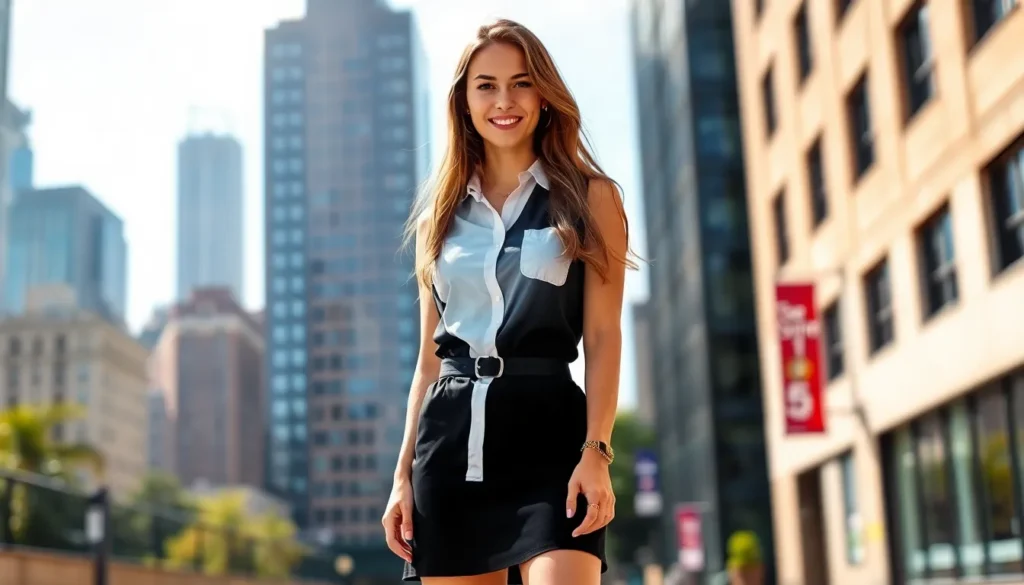We’ve all been there – staring at our closet wondering how to make that sleeveless dress work for the office or transform a simple sundress into something more sophisticated. The answer? Layering a shirt underneath your dress.
This styling technique isn’t just practical – it’s a fashion-forward way to extend your wardrobe’s versatility while creating completely new looks from pieces you already own. Whether you’re dealing with dress code requirements transitioning between seasons or simply want to add visual interest to your outfit, this layering method opens up endless possibilities.
From crisp button-downs peeking out beneath slip dresses to cozy turtlenecks under jumpers, we’ll show you how this simple styling trick can elevate your fashion game. The best part? You don’t need to buy anything new – just reimagine what’s already hanging in your wardrobe.
Choose the Right Dress Style for Layering With a Shirt Underneath
Selecting the perfect dress foundation makes layering with shirts underneath both stylish and comfortable. We’ll explore three versatile dress styles that work exceptionally well for this trending technique.
Sleeveless Shift Dresses
Sleeveless shift dresses offer the most versatile canvas for shirt layering experiments. These straight-cut garments provide ample room around the armholes and torso without clinging to your body. Classic A-line shifts work particularly well with fitted button-down shirts, while boxy cuts accommodate bulkier knits like cable sweaters or chunky cardigans.
Business professionals love pairing sleeveless shifts with crisp white shirts for office-appropriate looks. The structured silhouette maintains a polished appearance while the shirt adds coverage for conservative dress codes. Mini shift dresses transform into work-appropriate midi lengths when layered over longer button-downs or tunic shirts.
Fabric choice significantly impacts your layering success with shift dresses. Lightweight materials like cotton, linen, or silk blends drape beautifully over shirts without adding bulk. Structured fabrics such as ponte knits or wool blends maintain their shape while accommodating the extra layer underneath.
Tank Dress Options
Tank dresses with wider armholes create seamless layering opportunities for various shirt styles. The broader openings accommodate different sleeve lengths from cap sleeves to three-quarter options without bunching or pulling. Racerback tank dresses work especially well with collared shirts, allowing the collar to peek through attractively.
Bodycon tank dresses require careful shirt selection to maintain the sleek silhouette. Fitted turtlenecks or thin long-sleeve tees preserve the dress’s shape while adding coverage. Avoid bulky fabrics or loose-fitting shirts that create unflattering lumps or distort the dress’s intended silhouette.
Midi and maxi tank dresses offer extended styling possibilities with shirt layering. Longer lengths provide more coverage options, allowing you to experiment with cropped shirts, tied button-downs, or oversized sweaters. The extra fabric length balances proportions when adding volume on top through layering.
Wide-Strap Sundresses
Wide-strap sundresses provide excellent coverage for shirt straps and sleeves underneath. The broader shoulder coverage prevents visible bra straps or shirt seams from disrupting the overall look. These dresses typically feature more relaxed fits that accommodate additional layers comfortably.
Casual sundresses with wide straps pair beautifully with striped long-sleeve shirts or lightweight sweaters. The relaxed summer aesthetic combines effortlessly with preppy button-downs or bohemian blouses. Denim or chambray shirts create particularly appealing contrasts with flowy sundress fabrics like chiffon or cotton voile.
Adjustable wide straps offer customization options for different shirt necklines underneath. Loosening the straps slightly allows higher necklines like crew necks or mock turtlenecks to show through attractively. Tightening the straps works better with lower necklines or scoop-neck shirts that won’t compete with the dress’s neckline.
Select the Perfect Shirt to Wear Under Your Dress
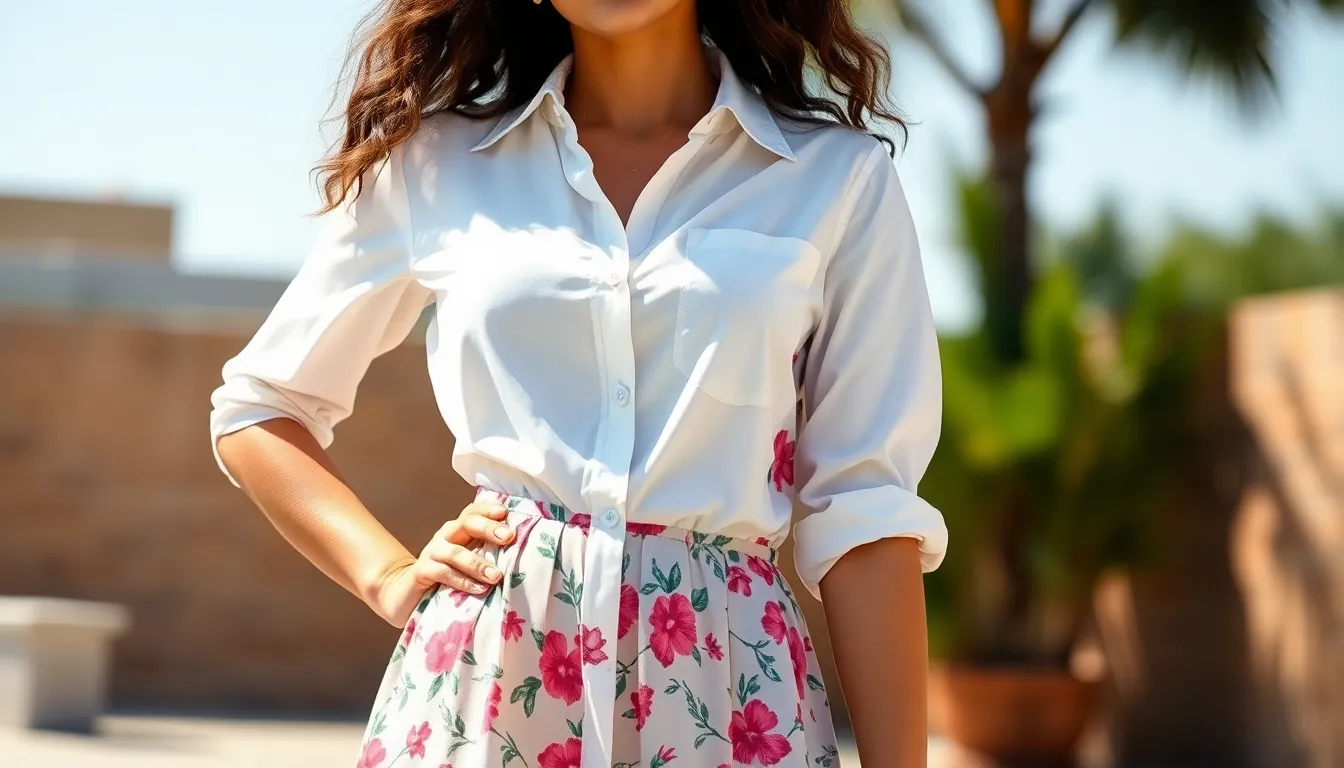
Choosing the right shirt transforms your dress layering game from amateur to expert. We’ll explore three essential shirt categories that create the most versatile and stylish combinations with your favorite dresses.
Classic White Button-Down Shirts
White button-down shirts serve as the ultimate foundation for dress layering because they complement virtually every dress style and color. We recommend choosing crisp cotton versions with clean lines that won’t compete with your dress’s silhouette.
Sleeves can be styled multiple ways to achieve different looks throughout the day. Roll them up for casual weekend vibes or keep them buttoned at the cuffs for professional settings. The collar adds structure to flowy dresses like slip styles or bohemian maxis.
Sizing matters significantly when selecting your white button-down for layering purposes. Choose one size smaller than your usual fit to prevent bulk under fitted dresses. Oversized versions work beautifully with mini dresses and create an effortlessly chic contrast.
Quality cotton blends offer the best combination of durability and comfort for frequent layering. We’ve found that shirts with at least 10% stretch maintain their shape better after multiple wears under dresses.
Fitted Long-Sleeve Tees
Fitted Long-Sleeve Tees create seamless layering opportunities without adding unnecessary bulk to your silhouette. We prefer modal or cotton blends that hug your body while allowing comfortable movement throughout the day.
Neutral colors like black, white, gray, and navy expand your styling options exponentially. These shades work with patterned dresses and allow your dress to remain the focal point of your outfit. Jewel tones can add subtle pops of color when paired with neutral or monochromatic dresses.
Neckline variety gives you multiple styling approaches with the same shirt style. Crew necks work perfectly under scoop neck dresses, while V-necks complement higher necklines beautifully. Mock necks add sophisticated touches to sleeveless shift dresses.
Fabric weight should remain lightweight to avoid creating lumpy layers under your dress. We recommend shirts under 200 GSM (grams per square meter) for the smoothest layering results.
Striped and Patterned Options
Striped shirts inject visual interest into solid-colored dresses while maintaining a classic aesthetic appeal. We gravitate toward thin stripes in navy and white combinations because they’re timeless and versatile across seasons.
Pattern mixing becomes effortless when you start with small-scale prints under your dresses. Pinstripes pair beautifully with floral dresses, while gingham checks complement solid colors and geometric patterns. The key lies in keeping one pattern significantly smaller than the other.
Color coordination doesn’t require perfect matches but should share at least one common hue. A red striped shirt works wonderfully under a navy dress that includes red accents or trim details. We suggest pulling one color from your dress’s pattern to create cohesive looks.
Contrast levels can make or break your patterned shirt and dress combinations. High contrast patterns like black and white stripes work best under solid dresses, while subtle tonal variations complement busier dress patterns without overwhelming your overall look.
Master the Art of Proportions When Styling a Dress With Shirt Underneath
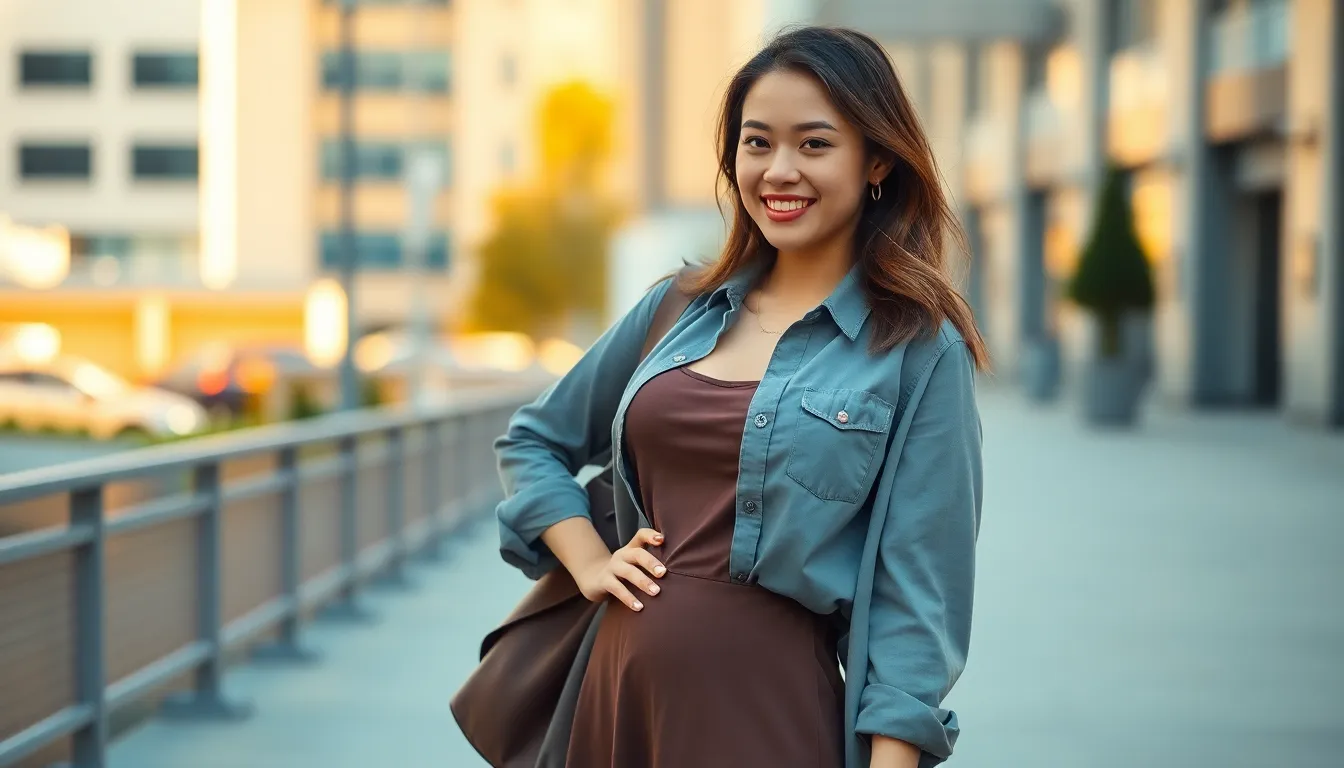
Getting the proportions right transforms a simple layered outfit into a polished, intentional look. We’ll show you how to create balanced silhouettes that flatter your body and elevate your style.
Balancing Loose and Fitted Pieces
Fitted dresses work best with relaxed shirts underneath, creating visual contrast that prevents the outfit from looking too structured. Bodycon dresses pair beautifully with oversized button downs or loose turtlenecks, allowing the shirt to peek out naturally at the neckline and sleeves. The key lies in choosing one fitted piece and one relaxed piece to maintain harmony.
Flowy dresses require more fitted underlayers to avoid overwhelming your frame with too much fabric. A-line dresses and maxi styles benefit from slim-fit tees or fitted blouses that won’t add bulk. Sleeveless shift dresses in particular shine when paired with form-fitting long sleeve shirts that complement rather than compete with the dress silhouette.
Proportional balance extends to fabric weight as well. Lightweight chiffon dresses need equally light cotton tees or silk blouses underneath, while structured wool dresses can handle slightly thicker knits. We recommend testing different combinations to find what feels most comfortable and looks most polished.
Length Considerations for Both Layers
Shirt sleeves should extend beyond the dress hemline by 1-2 inches to create intentional layering that looks purposeful rather than accidental. Midi dresses work exceptionally well with this technique, allowing long sleeve shirts to peek out elegantly below the hemline. The contrast creates visual interest while maintaining sophistication.
Mini dresses offer the most flexibility with shirt lengths, permitting everything from cropped tees to tunic-style button downs underneath. We’ve found that longer shirts underneath mini dresses create a trendy, effortless vibe that’s perfect for weekend styling. The key is ensuring the shirt length doesn’t overwhelm the dress proportions.
Maxi dresses present unique layering challenges that require careful attention to shirt length. Shorter shirts work best with empire waist maxis, while longer tunics complement straight-cut maxi styles. The goal is maintaining the dress’s intended silhouette while adding the desired coverage and style elements.
Neckline Coordination Tips
Scoop neck dresses pair beautifully with crew neck shirts, creating clean lines that don’t compete for attention. The shirt neckline should sit slightly lower than the dress neckline to create subtle layering without overwhelming the look. We recommend choosing shirts in coordinating colors to maintain visual cohesion.
V-neck dresses offer versatility with multiple shirt neckline options, from turtlenecks that create dramatic contrast to collared shirts that add preppy sophistication. Button down shirts work particularly well with V-neck styles, allowing you to adjust the collar positioning for different occasions. The contrast between sharp V-lines and rounded collars creates appealing visual tension.
High necklines require strategic underlayer selection to avoid creating a cluttered appearance around the face and neck area. Sleeveless tanks work best under mock neck dresses, while crew neck tees complement turtleneck dress styles. We suggest keeping the color palette minimal when working with high necklines to maintain elegance and avoid visual overwhelm.
Create Seasonal Looks Using the Dress With Shirt Underneath Trend
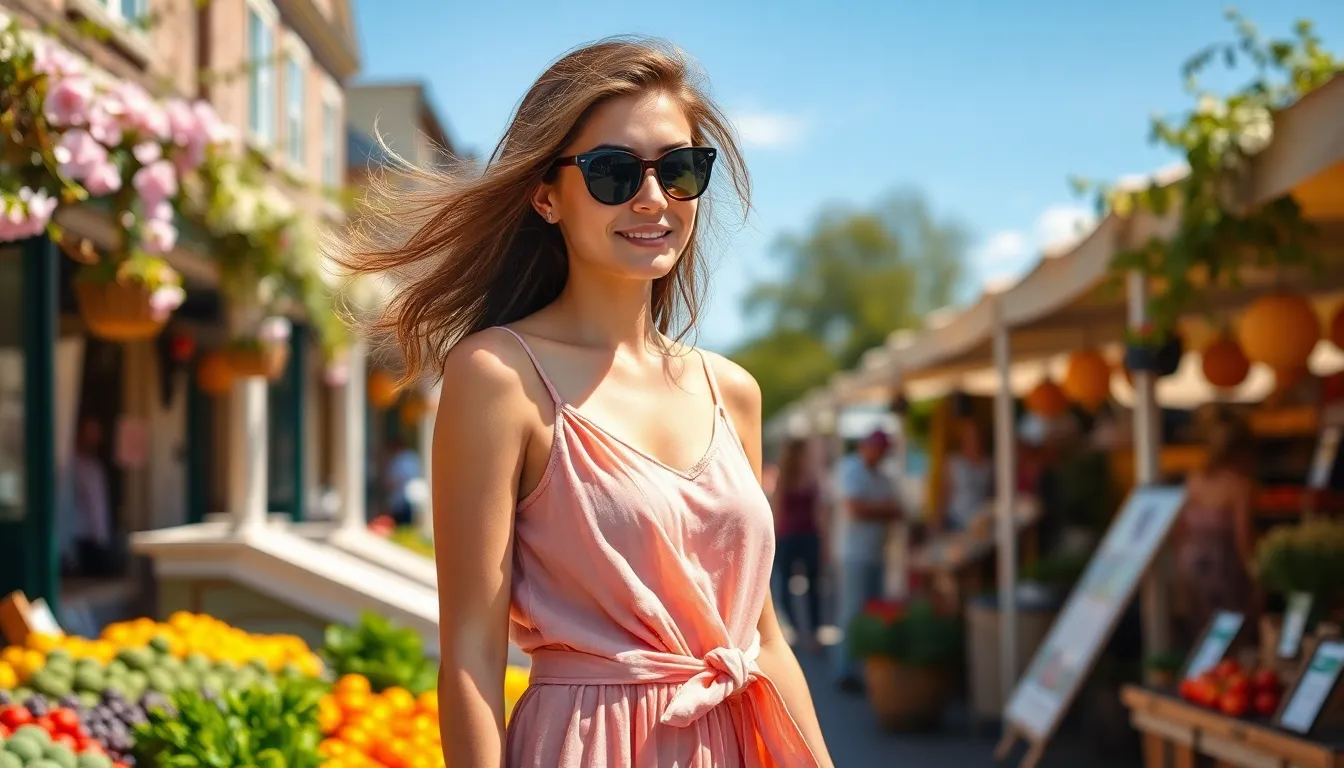
Seasonal changes require outfit adaptability, and the dress with shirt underneath trend delivers year-round styling answers. We’ll explore how to maximize this layering technique across different weather conditions.
Spring and Summer Styling Ideas
Lightweight cotton button-downs work perfectly under sleeveless sundresses during warmer months. Roll the sleeves to three-quarter length and tie the shirt at the waist for a breezy, casual look that’s ideal for weekend brunches or outdoor markets.
Thin striped tees create effortless summer combinations when layered beneath tank dresses. Choose breathable fabrics like modal or bamboo blends that won’t add bulk or trap heat against your skin during hot weather.
Cropped white shirts pair beautifully with midi sundresses, allowing the dress hemline to take center stage while providing modest coverage for conservative settings. Leave a few buttons undone at the neckline to maintain airflow and visual interest.
Sleeveless button-downs offer the perfect compromise for transitioning from air-conditioned offices to warm outdoor spaces. Layer them under shift dresses and add a lightweight cardigan that you can easily remove as temperatures rise.
Fall and Winter Layering Techniques
Turtlenecks in neutral tones become essential underlayers for sleeveless dresses during colder months. Choose fitted styles in merino wool or cashmere blends that provide warmth without creating uncomfortable bulk around the torso.
Long-sleeve thermal shirts work exceptionally well under jumper dresses, extending wear into winter months. Select moisture-wicking fabrics that regulate body temperature while maintaining a sleek silhouette beneath heavier dress materials.
Chunky knit sweaters can replace traditional shirts when layered under wide-strap dresses or overalls-style pieces. This approach creates cozy, textural contrast while maximizing warmth during the coldest months.
Button-down shirts with thermal underlayers provide double protection against harsh weather. Layer a thin thermal base, then add your shirt, and finish with the dress for a sophisticated look that handles office heating and outdoor commutes.
Transitional Weather Answers
Lightweight cardigans over shirt and dress combinations adapt seamlessly to unpredictable spring and fall temperatures. Choose open-front styles that won’t compete with your layered necklines while providing easy temperature control.
Three-quarter sleeve shirts bridge the gap between summer tanks and winter long sleeves when worn under sleeveless dresses. This length works particularly well during September and April when morning chill gives way to afternoon warmth.
Denim shirts in varying weights offer versatile transitional layering options. Light chambray works for early fall, while heavier denim provides structure and warmth as temperatures drop further.
Blazers as the final layer complete transitional outfits by adding professional polish and extra warmth. Choose unstructured styles that accommodate the shirt and dress layers without creating a boxy silhouette around your shoulders and arms.
Accessorize Your Dress With Shirt Underneath Outfit
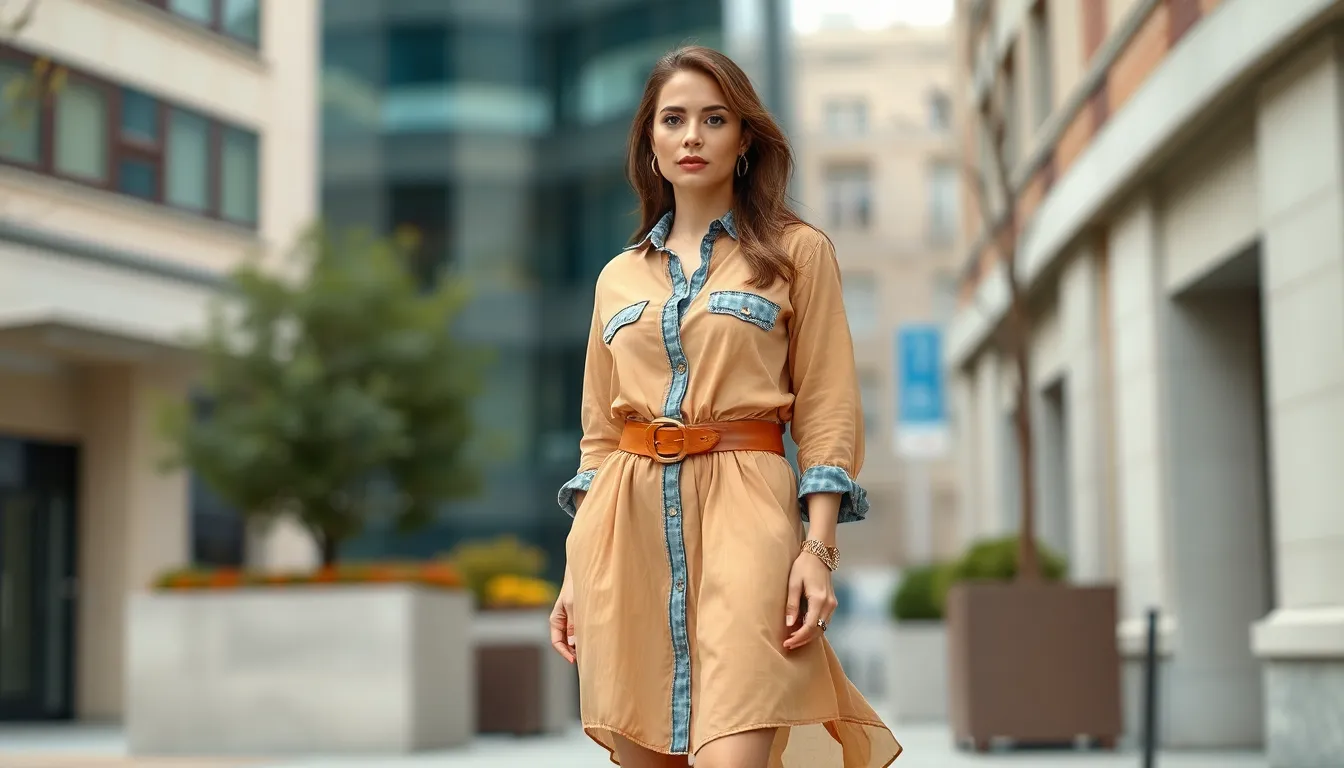
Strategic accessories can transform your layered dress and shirt combination into a truly sophisticated ensemble. We’ll explore key accessory elements that enhance this versatile styling technique.
Belt Placement and Selection
Belt placement becomes crucial when layering shirts underneath dresses to create definition and visual structure. We recommend positioning wide belts at your natural waist to cinch flowy dresses over fitted button-downs. Thin belts work exceptionally well with shift dresses and long-sleeve tees, creating a streamlined silhouette that doesn’t compete with the layered elements.
Leather belts in neutral tones like black, brown, or cognac complement most dress and shirt combinations without overwhelming the look. Chain belts add a contemporary edge to casual weekend outfits featuring striped shirts under tank dresses. Statement belts with unique buckles can serve as focal points when wearing monochromatic layered pieces.
Placement strategies vary depending on your dress silhouette and desired outcome. High-waisted belts elongate the legs when wearing midi dresses over turtlenecks. Hip-level belts create relaxed vibes perfect for sundresses layered with denim shirts during transitional seasons.
Jewelry Choices for Layered Looks
Jewelry selection requires careful consideration to avoid competing with the visual interest created by layered textures and patterns. We suggest starting with delicate pieces that complement rather than overwhelm your dress and shirt combination. Thin gold or silver chains work beautifully with button-down shirts peeking out from sleeveless dresses.
Earring choices should balance the overall complexity of your layered outfit. Stud earrings or small hoops maintain elegance when wearing patterned shirts under solid dresses. Statement earrings can anchor looks featuring simple white tees layered beneath minimalist shift dresses.
Layered necklaces create depth without adding bulk to your outfit. We recommend mixing different chain lengths to frame the neckline area where your shirt and dress intersect. Pendant necklaces work particularly well with crew neck shirts under scoop neck dresses, filling the visual space attractively.
Bracelet and ring selection should consider the sleeve length of your layered shirt. Delicate bracelets complement three-quarter sleeve shirts under sleeveless dresses. Bold cuff bracelets pair nicely with long-sleeve thermal shirts extending beyond dress hemlines during colder months.
Footwear Options to Complete the Style
Footwear choices can dramatically shift the overall vibe of your dress and shirt combination from casual to professional or trendy to classic. We’ve identified key shoe categories that work seamlessly with layered outfits across different occasions and seasons.
Ankle boots provide versatility for fall and winter layered looks featuring turtlenecks under jumper dresses. Leather ankle boots in black or brown complement most color combinations while adding sophisticated edge. Suede options soften the overall appearance when wearing chunky knit sweaters over dress bases.
Sneakers create relaxed weekend vibes perfect for casual dress and shirt combinations. White leather sneakers pair beautifully with striped shirts under tank dresses during spring and summer months. Canvas sneakers in neutral tones complement denim shirts layered beneath sundresses for effortless weekend styling.
Loafers bridge casual and professional styling when wearing button-down shirts under shift dresses for work environments. Pointed-toe loafers elongate the leg line while maintaining comfort throughout busy days. Penny loafers add preppy charm to wide-strap sundresses layered over fitted long-sleeve tees.
Heeled options elevate layered looks for evening events or professional settings. Block heels provide stability while walking in midi dresses over thermal shirts during transitional weather. Pointed-toe pumps create sleek silhouettes when wearing fitted button-downs under sleeveless shift dresses for important meetings.
Style Different Dress Types With Shirts for Various Occasions

Creating the perfect layered look depends on understanding which dress and shirt combinations work best for exact settings. We’ll show you how to adapt this versatile styling technique across different occasions while maintaining both comfort and sophistication.
Casual Day Outfits
Denim shift dresses paired with striped long-sleeve tees create effortless weekend looks that feel relaxed yet put-together. We recommend rolling up the shirt sleeves slightly to show intentional layering while maintaining the casual vibe.
Cotton sundresses layered over fitted white tees offer perfect comfort for running errands or meeting friends for brunch. The lightweight combination allows for easy movement while adding visual interest through contrasting textures.
Midi tank dresses work beautifully with oversized button-downs tied at the waist for a trendy, laid-back appearance. This styling approach transforms a simple dress into a statement outfit that’s perfect for farmer’s markets or casual shopping trips.
Jersey knit dresses gain structure when paired with cropped denim shirts underneath. The combination creates a balanced silhouette that’s ideal for outdoor activities or casual lunch dates.
Professional Work Attire
Sleeveless sheath dresses paired with crisp white button-downs underneath deliver polished office looks that meet dress code requirements. We suggest keeping the shirt collar visible for a sophisticated layered effect that commands respect in professional settings.
Black shift dresses layered over neutral turtlenecks create elegant winter workwear that transitions seamlessly from meetings to networking events. The monochromatic approach maintains professionalism while providing necessary warmth.
A-line midi dresses combined with fitted long-sleeve blouses offer versatility for client presentations and important meetings. Choose solid colors for the shirt to keep the focus on the dress silhouette while ensuring appropriate coverage.
Wrap dresses work exceptionally well with thin crew neck sweaters underneath for conservative work environments. This combination provides modest coverage while maintaining the dress’s flattering shape and feminine appeal.
Weekend and Social Events
Slip dresses paired with vintage band tees create edgy looks perfect for concerts or casual date nights. We love how this unexpected combination balances feminine and rebellious elements for unique social occasions.
Floral sundresses layered over white long-sleeve tees deliver sweet, romantic vibes ideal for garden parties or brunch with friends. The contrast between delicate florals and crisp cotton creates visual appeal without being overwhelming.
Little black dresses gain casual appeal when styled with striped Breton shirts underneath for gallery openings or weekend cultural events. This French-inspired combination feels effortlessly chic and intellectually stylish.
Maxi dresses paired with cropped fitted tees work wonderfully for outdoor festivals or beach gatherings. The layering adds coverage while maintaining the dress’s flowing movement and bohemian aesthetic.
Avoid Common Mistakes When Wearing a Dress With Shirt Underneath
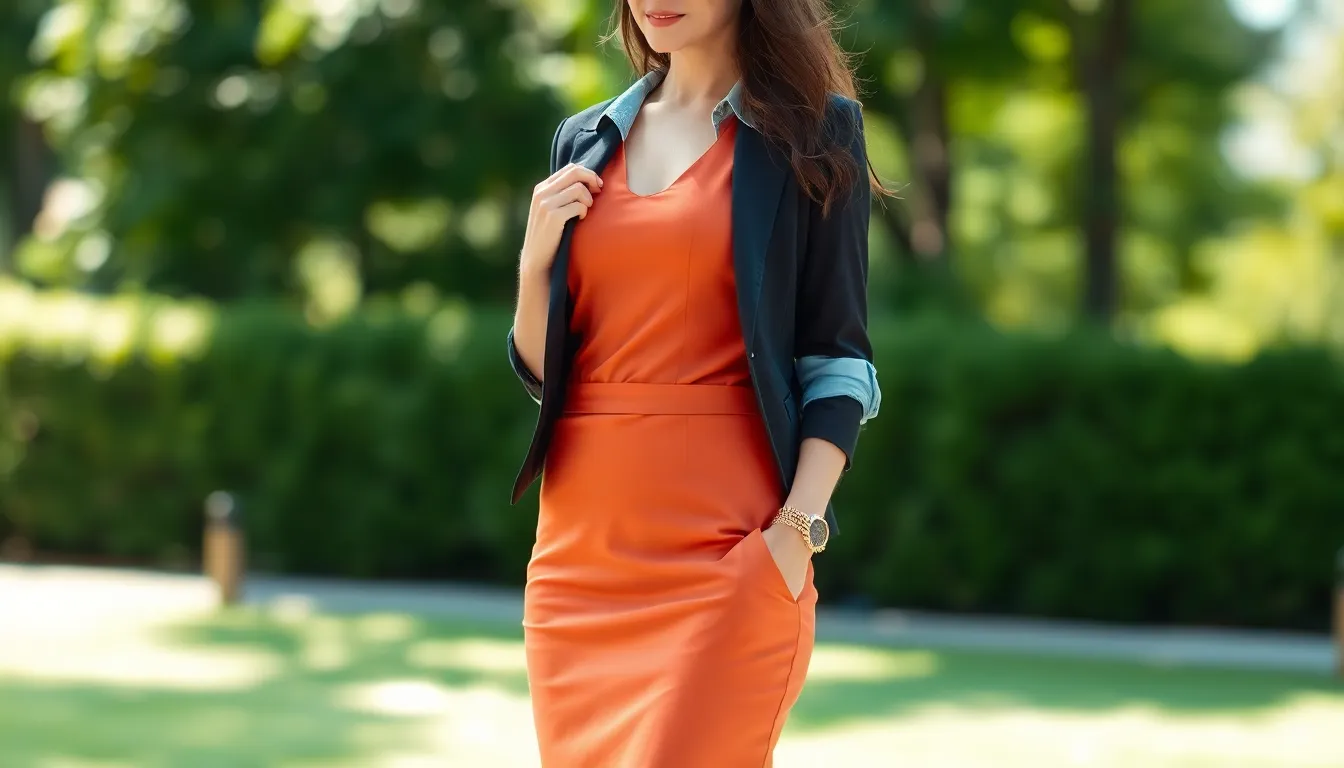
Even the most stylish layering attempts can fall flat when we overlook key styling principles. These common pitfalls can transform a chic ensemble into a fashion misstep that detracts from our overall look.
Fabric Clash Prevention
Mixing incompatible textures creates visual discord that undermines our entire outfit. Satin dresses paired with cotton flannel shirts produce an awkward contrast that feels disjointed and unpolished. We should avoid combining formal fabrics like silk or velvet with casual materials such as jersey knits or terry cloth.
Selecting fabrics with similar weight prevents one layer from overpowering the other. Lightweight cotton shirts work beautifully under chiffon or crepe dresses because both materials have comparable drape and movement. Heavy wool sweaters beneath delicate sundresses create an unbalanced look that appears forced rather than intentional.
Understanding fabric care requirements helps us maintain both pieces properly over time. Dry clean only dresses shouldn’t be layered with machine washable shirts that might shrink or fade differently. We recommend checking care labels before committing to exact combinations to ensure long term wearability.
Avoiding Bulk and Unflattering Silhouettes
Oversized shirts beneath fitted dresses create unflattering bunching that adds unnecessary volume. Baggy button downs tucked under bodycon dresses produce lumpy silhouettes that hide our natural shape. We should choose slim fit or customized shirts that lay flat against our body without creating bulk at the waistline.
Poor length proportions disrupt the intended aesthetic of both garments. Shirts that extend far beyond dress hems make legs appear shorter and create an unfinished appearance. We recommend ensuring shirt sleeves extend only 1-2 inches past dress sleeves for deliberate layering that looks purposeful rather than accidental.
Incorrect sizing in either layer compromises the entire ensemble’s fit and comfort. Shirts that are too tight create pulling and stretching under dresses while overly loose fits bunch awkwardly. We suggest trying on complete combinations rather than assuming individual pieces will work together seamlessly.
Color Coordination Pitfalls
Clashing undertones between shirt and dress colors create visual tension that’s hard to ignore. Cool toned navy dresses paired with warm toned cream shirts produce an unsettling contrast that lacks harmony. We should identify whether our pieces have warm, cool, or neutral undertones before combining them in layered looks.
Competing patterns overwhelm the eye and create chaotic visual noise. Floral dresses layered over striped shirts result in pattern overload that detracts from both pieces’ individual beauty. We recommend limiting ourselves to one statement pattern while keeping the other layer solid or subtly textured.
Insufficient contrast makes layered pieces blend together and lose their intended impact. Light gray shirts under pale pink dresses disappear entirely and waste the layering opportunity. We should ensure enough tonal difference exists between layers so each piece remains visible and contributes to the overall aesthetic.
Conclusion
We’ve explored how layering a shirt underneath a dress transforms your wardrobe into a versatile styling powerhouse. This technique doesn’t just extend your outfit options—it creates entirely new looks while maximizing what you already own.
The key lies in understanding proportions fabric compatibility and color coordination. When we master these fundamentals we can confidently layer across seasons and occasions without making common styling mistakes.
Remember that the best layered looks feel intentional rather than accidental. By selecting the right dress styles pairing them with complementary shirts and finishing with thoughtful accessories we create outfits that are both practical and stylish. This approach proves that fashion innovation doesn’t require a shopping spree—just creativity and confidence.
Frequently Asked Questions
What is the dress with shirt underneath styling technique?
This styling technique involves layering a shirt beneath a dress to create versatility and new looks from existing wardrobe pieces. It helps navigate dress codes, seasonal transitions, and adds visual interest to outfits without requiring new purchases.
Which dress styles work best for layering with shirts?
Three versatile dress styles work best: sleeveless shift dresses (serve as a versatile canvas), tank dresses with wider armholes (allow seamless layering), and wide-strap sundresses (provide excellent coverage for various shirt necklines).
What types of shirts should I choose for layering under dresses?
Three essential shirt types include classic white button-downs (foundational piece that complements nearly every dress), fitted long-sleeve tees in neutral colors, and striped or patterned options that add visual interest while maintaining color coordination.
How do I balance proportions when layering a dress with a shirt?
Balance loose and fitted pieces by pairing relaxed shirts with fitted dresses and fitted underlayers with flowy styles. Ensure shirt sleeves extend beyond the dress hemline for intentional layering, and coordinate necklines for visual cohesion.
How can I adapt this layering technique for different seasons?
For spring/summer, use lightweight cotton button-downs and thin striped tees. In fall/winter, opt for turtlenecks, thermal shirts, and chunky knit sweaters. For transitional weather, try lightweight cardigans, three-quarter sleeve shirts, and denim shirts.
What accessories work best with layered dress and shirt outfits?
Use strategic belt placement (wide belts at natural waist for flowy dresses, thin belts for shift dresses), delicate jewelry that won’t overwhelm the layers, and versatile footwear like ankle boots, sneakers, loafers, or heeled shoes.
What are common mistakes to avoid when layering dresses with shirts?
Avoid fabric clashes by selecting compatible textures with similar weights, ensure proper fit and length proportions, prevent color coordination issues with clashing undertones, and maintain sufficient contrast so each layer remains visible and contributes to the aesthetic.

